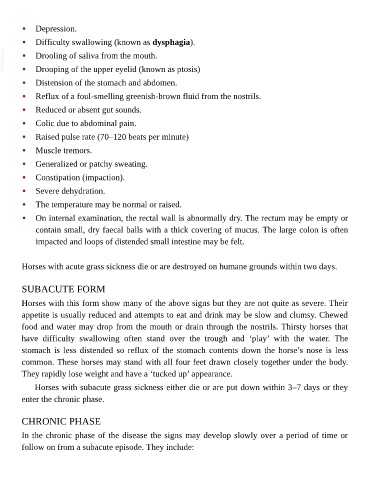Page 507 - The Veterinary Care of the Horse
P. 507
• Depression.
• Difficulty swallowing (known as dysphagia).
VetBooks.ir • Drooling of saliva from the mouth.
•
Drooping of the upper eyelid (known as ptosis)
• Distension of the stomach and abdomen.
• Reflux of a foul-smelling greenish-brown fluid from the nostrils.
• Reduced or absent gut sounds.
• Colic due to abdominal pain.
• Raised pulse rate (70–120 beats per minute)
• Muscle tremors.
• Generalized or patchy sweating.
• Constipation (impaction).
• Severe dehydration.
• The temperature may be normal or raised.
• On internal examination, the rectal wall is abnormally dry. The rectum may be empty or
contain small, dry faecal balls with a thick covering of mucus. The large colon is often
impacted and loops of distended small intestine may be felt.
Horses with acute grass sickness die or are destroyed on humane grounds within two days.
SUBACUTE FORM
Horses with this form show many of the above signs but they are not quite as severe. Their
appetite is usually reduced and attempts to eat and drink may be slow and clumsy. Chewed
food and water may drop from the mouth or drain through the nostrils. Thirsty horses that
have difficulty swallowing often stand over the trough and ‘play’ with the water. The
stomach is less distended so reflux of the stomach contents down the horse’s nose is less
common. These horses may stand with all four feet drawn closely together under the body.
They rapidly lose weight and have a ‘tucked up’ appearance.
Horses with subacute grass sickness either die or are put down within 3–7 days or they
enter the chronic phase.
CHRONIC PHASE
In the chronic phase of the disease the signs may develop slowly over a period of time or
follow on from a subacute episode. They include:

